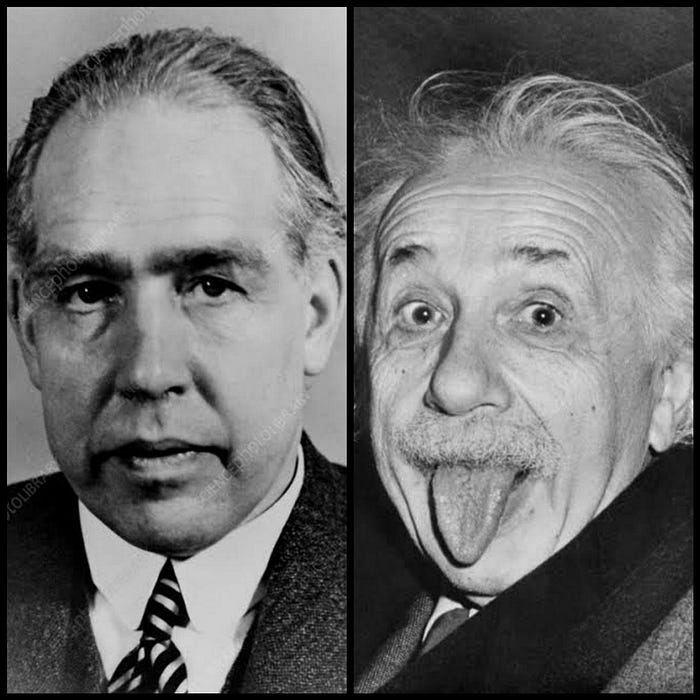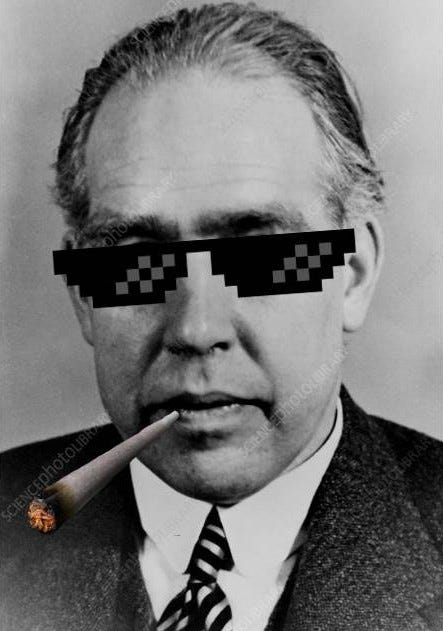When Neils Bohr Outwitted Albert Einstein

If you have studied elementary physics, you must have heard both of these names. Neils Bohr is a well known figure when it comes to Quantum Physics. And I really don’t think Einstein needs any introduction. Many school students are introduced to Bohr as the one who gave Bohr’s Model of Hydrogen Atom. Einstein name is mostly associated with his theories of Special and General Relativity. Both of these dramatically new concepts were introduced into the world of physics at the dawn of 20th century. But alas, they refused to go hand in hand.
(There is a fabulous book written on this subject by George Gamow titled Thirty Years That Shook Physics, from where this incident is taken)
It is a well known fact that Einstein never accepted the uncertainty which was inherent in Quantum Mechanics. There is very popular quote by Einstein on this matter:
“Quantum theory yields much, but it hardly brings us close to the Old One’s (God’s) secrets. I, in any case, am convinced He does not play dice with the universe.”
Till his last breath, he worked to provide a theory which could explain the Quantum phenomena without any uncertainty. During his time too, many physicists worked to combine the theories of Relativity and Quantum Mechanics. And that work is incomplete till date.
But these days people don’t actually know the genius of Einstein’s contemporaries, including that of Bohr.
Background :
This incident took place in Brussels at the Sixth Solvay Congress (1930), which was dedicated to the problems of Quantum Theory, and it involved the uncertainty relation in four coordinates.
For those who don’t know, the Uncertainty Principle states :
The more precisely the position of some particle is determined, the less precisely its momentum can be predicted from initial conditions, and vice versa.
More formally, if ∆r is the uncertainty in position of the particle, and ∆p be the uncertainty in momentum of the particle, then
∆r∙∆p ≅h, where h is the Plank’s constant.
In three dimensional coordinate system, there are three independent relations like these:
∆x∙∆px ≅h
∆y∙∆py ≅h
∆z∙∆pz ≅h
In the theory of Relativity, time serves as the fourth coordinate, and Energy/c (E/c, c = speed of light in vacuum) serves as the fourth component of Mechanical momentum, the fourth relation can be written as
∆t∙∆E ≅h.
It was this fourth relation which Einstein sought to prove wrong using an ideal experiment.
The Experiment:
Suppose there is a box inlaid with ideal mirrors. There is a clock based shutter (which is ideal) in the box which will open and subsequently close at the time set in the clock. The box is filled with a certain amount of light (i.e. radiant energy). The box is weighed before the clock opens the shutter. Weighing can be done to any desired precision. Now the clock operates at the set time. The shutter opens, lets out some of the radiant energy, and closes again. The box is weighed again to the same desired precision. The difference in the masses of the box after these measurements (m2-m1 = ∆m) is noted. Multiplying ∆m by c² will give us the amount of radiant energy which escaped from the shutter. Hence all energy is accounted for (i.e. there is no unaccounted loss of energy anywhere). This means ∆E= 0. Since the clock is also ideal, there is no uncertainty in the measurement of time, i.e. ∆t = 0.
⇒ ∆t∙∆E = 0.
Apparently, there is no flaw in this argument. Everyone at the Congress thought so. Even Bohr. He did not say anything at the moment.
Bohr’s Brain In Action:
Bohr kept on thinking about that experiment the whole night. Next morning he appeared at the meeting with a radiant face showing that he had achieved his Eureka moment. His argument was as follows :
- In order to weigh the box, it would need to move in the vertical direction, no matter what the method may be (balance scales or spring scales).
- According to one of the most famous theories in Physics at that time, if the clock (along with the box) changed it’s position in the gravitational field of Earth, it would gain or lose time. This introduces an uncertainty ∆t≠0 in the time the shutter would open. (Can you guess the ‘famous theory’?)
- On the other hand, the amplitude of the vertical oscillations of the box and mass change due to energy loss are connected through the ordinary relation ∆z∙∆pz ≅h.
- Doing some mathematical manipulations, he could show that ∆t∙∆E ≅h.
Well, he proved Einstein wrong. That’s okayish. But were you able to guess the ‘famous theory’ he used to prove him wrong? It was none other than Einstein’s Theory of General Relativity.
Now that is what you call thug life.

